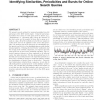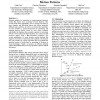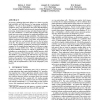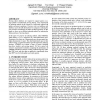99
Voted
SIGMOD
2004
ACM
16 years 24 days ago
2004
ACM
Subsequence similarity matching in time series databases is an important research area for many applications. This paper presents a new approximate approach for automatic online s...
106
click to vote
SIGMOD
2004
ACM
16 years 24 days ago
2004
ACM
We present several methods for mining knowledge from the query logs of the MSN search engine. Using the query logs, we build a time series for each query word or phrase (e.g., `Th...
120
Voted
SIGMOD
2004
ACM
16 years 24 days ago
2004
ACM
Peer data management systems (PDMS) offer a flexible architecture for decentralized data sharing. In a PDMS, every peer is associated with a schema that represents the peer's...
100
click to vote
SIGMOD
2004
ACM
16 years 24 days ago
2004
ACM
Existing methods for prediction in spatio-temporal databases assume that objects move according to linear functions. This severely limits their applicability, since in practice mo...
104
Voted
SIGMOD
2004
ACM
16 years 24 days ago
2004
ACM
We present a technique that masks failures in a cluster to provide high availability and fault-tolerance for long-running, parallelized dataflows. We can use these dataflows to im...
113
click to vote
SIGMOD
2004
ACM
16 years 24 days ago
2004
ACM
In this paper we present an efficient, scalable and general algorithm for performing set joins on predicates involving various similarity measures like intersect size, Jaccard-coe...
107
click to vote
SIGMOD
2004
ACM
16 years 24 days ago
2004
ACM
Current day database applications, with large numbers of users, require fine-grained access control mechanisms, at the level of individual tuples, not just entire relations/views,...
SIGMOD
2004
ACM
16 years 24 days ago
2004
ACM
105
Voted
SIGMOD
2004
ACM
16 years 24 days ago
2004
ACM
XML is widely praised for its flexibility in allowing repeated and missing sub-elements. However, this flexibility makes it challenging to develop a bulk algebra, which typically ...
118
Voted
SIGMOD
2004
ACM
16 years 24 days ago
2004
ACM
We study the problem of answering queries through a target schema, given a set of mappings between one or more source schemas and this target schema, and given that the data is at...





